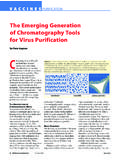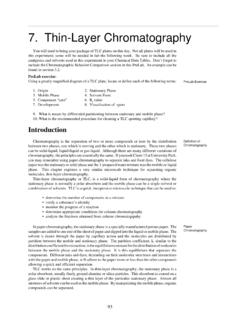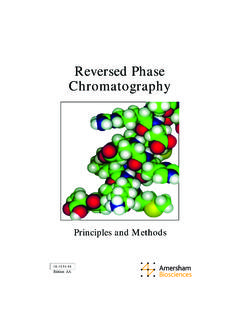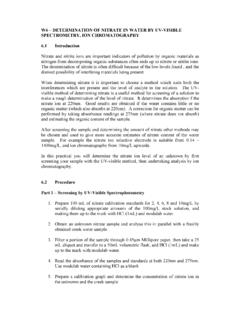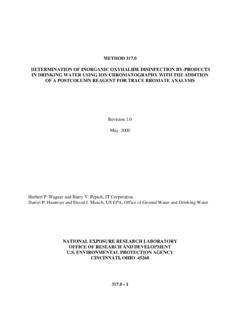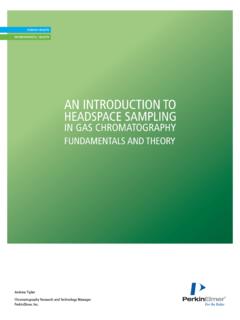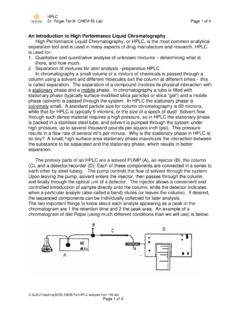Transcription of CHROMIUM, HEXAVALENT 7605 by Ion …
1 NIOSH Manual of Analytical Methods (NMAM), Fourth EditionCHROMIUM, HEXAVALENT7605by Ion ChromatographyCr(VI)MW: (Cr); (CrO3)CAS: 18540-29-9 RTECS: GB6262000 METHOD: 7605, Issue 1 EVALUATION: FULLI ssue 1: 15 March 2003 OSHA mg/m3 (as CrO3) mg/m3/10 h; mg/m3 (as Cr, soluble); some insolublechromates are human carcinogensPROPERTIES:oxidizing agentSYNONYMS: Vary depending upon the compound; chromate commonly used, chrome six. SAMPLINGMEASUREMENTSAMPLER:FILTER( :m PVC membrane)FLOW RATE:1 to 4 L/minVOL-MIN:1 L @ mg/m3 -MAX:400 LSHIPMENT:Routine. Can be shipped cold when :Stable for 2 weeks at room for 4 weeks if stored in :2 to 10 field blanks per setTECHNIQUE:Ion chromatography with post-columnderivatization and UV :CrO4-2-diphenylcarbazide (DPC) complexEXTRACTION:5 mL 2% NaOH- 3% Na2CO3. Dilute to25 mL after :100 :LCOLUMN:Dionex NG1 Guard, HPIC- AS7 Separator or equivalentMOBILE PHASE:250 mM (NH4)2SO4 /100 mM NH4 OHFLOW mL/min; mL/min post columnPOST- mM DPC + 10% MeOH +1N H2SO4 DETECTOR:540 nmCALIBRATION:Standard solutions of K2Cr2O7 inNaOH-Na2CO3 to 20 :g per sampleESTIMATED :g per sample [3]PRECISION ( r) @ to 5 :g/sample [3]ACCURACYRANGE to 120 :g Cr(VI) [1,2] [2]OVERALL PRECISION ( rT) : ( - 960 :g/m3) [1]APPLICABILITY: The working range is to mg/m3 for a 200-L air sample.
2 This method can be used for thedetermination of Cr(VI) using 2% NaOH - 3% Na2CO3 for : Possible interferences are iron, copper, nickel, and vanadium; 10 :g of any of these causes an absorbanceequivalent to approximately :g Cr(VI) due to formation of colored complexes. Interference due to reducing agents ( , Fe,Fe++) is minimized by alkaline extraction (step 5).OTHER METHODS: Method 7703 is a field portable method for Cr(VI). OSHA Method W4001 is for the measurement of Cr(VI)in wipe samples [4]. OSHA Method ID-215 is for measurement of Cr(VI) and employs precipitation to reduce Cr(III) oxidation. [5]. A similar air method is ISO 16740 [6]. EPA Method is for water matrices [7]. Method 7604 is also specific forhexavalent chromium, using ion chromatography, but has a higher detection limit than , HEXAVALENT : Method 7605, Issue 1 dated 15 March 2003 - Page 2 of 5 NIOSH Manual of Analytical Methods (NMAM), Fourth EditionREAGENTS: acid, conc.
3 (98% w/w).* hydroxide, conc. (28%).* sulfate monohydrate, reagentgrade. carbonate, anhydrous. hydroxide, reagent grade.* , HPLC grade.* ,5-Diphenylcarbazide, reagent grade. dichromate or potassiumchromate.* Dry at 100 C and store in adesiccator. Derivatizing Reagent:Diphenylcarbazide solution. Dissolve 500 mg1,5-diphenylcarbazide in 100 mLHPLC-grade methanol. While stirring, add500 mL water containing 28 mL of acid. Dilute to a final volume of oneliter with water. This reagent is stable for 4 - 5days. Prepare in one-liter quantities (VI) standard, 1000 :g/mL. Dissolve potassium dichromate in deionized water tomake one liter, or use commercially : g K2 CrO4 can also be stock solution, :g/mL. Dilute1000 :g/mL Cr(VI) standard 1:1000 withdeionized extraction solution, 2% NaOH-3%Na2CO3. Dissolve 20 g NaOH and 30 gNa2CO3 in deionized water to make one literof (mobile phase); 250 mM ammoniumsulfate/200 mM ammonium 33 g ammonium sulfate inapproximately 500 mL distilled water and mL conc.
4 Ammonium hydroxide. Dilute toone liter with distilled water and , pre-purified.* See SPECIAL PRECAUTIONSEQUIPMENT: : polyvinyl chloride (PVC) filter, :m pore size, 37-mm diameter inpolystyrene cassette filter :Some PVC filters promote reductionof Cr(VI). Check each lot of filters forrecovery of Cr(VI) standard. sampling pump, 1 to 4 L/min, withflexible connecting tubing. , scintillation, 20-mL glass, PTFE-linedscrew cap.** , nonmetallic. , polypropylene or latex. chromatography apparatus consistingof autosampler; pump; NG1 (Dionex Corp.)or equivalent guard column; HPIC-AS7, 4 x250-mm (Dionex Corp.) separator column (orequivalent); post-column reagent deliverysystem, PEEK tubingmixing/reaction loop with 1 m in a water bathat 32 C 3 C; and UV detector. apparatus, PTFE luer-lock filter(Gelman IC Acrodisc or equivalent)/syringe. , borosilicate, 50-mL.** glass.
5 ** flasks, 25-, 100-, and 1000-mL.** at 107 C, not to exceed 115 : Hot plate can be used. An ultrasonicbath can be used instead of oven or , 10-:L to , TD 5-mL.** refrigerant. **Clean all glassware with 1:1 HNO3:H2O andrinse thoroughly before PRECAUTIONS: Many chromate compounds are suspected human carcinogens [8]. Allsample preparation should be performed in a hood. Concentrated acids and bases are toxic andcorrosive. When working with concentrated acids and bases, wear protective clothing. Ammoniumhydroxide is a respiratory irritant. Methanol is flammable and : the sampling pump with a representative sampler in line. at an accurately known flow rate in the range 1 to 4 L/min for a sample size of 1 to 400 L. Do notexceed 1 mg total dust loading on the , HEXAVALENT : Method 7605, Issue 1 dated 15 March 2003 - Page 3 of 5 NIOSH Manual of Analytical Methods (NMAM), Fourth Edition can be left in the cassettes for shipping to the lab, but to minimize sample contamination duringshipping, remove the filter from the cassette within one hour of completion of sampling and place it in avial to be shipped to the laboratory.
6 Handle the filter only with gloved hands and nonmetallic the backup pad. As a precaution, it is recommended to ship the samples with bagged PREPARATION: a clean pair of disposable plastic gloves (to prevent sample contamination). Using forceps, transferthe PVC filter to a 50-mL beaker, and add mL filter extraction solution, 2% NaOH/3% Na2CO3. Startmedia blanks at this point. NOTE 1:If significant amounts of Cr[III] are expected to be present in the samples, either (a) degas thesodium hydroxide/sodium carbonate extraction solution by bubbling nitrogen through it for 5min. before proceeding, or (b) use a precipitation reagent [1]. NOTE 2:If only soluble chromates are of interest, use ammonium sulfate buffer in place of carbonateextraction solution [9, 10]. the beaker with a watchglass and heat it to near the boiling point (100 C to 115 C) in an oven withoccasional swirling for 45 min.
7 Do not boil the solution. Longer heating times (up to 90 minutes) maybe necessary for some samples ( , paint spray). Do not allow the solution to evaporate to drynessbecause HEXAVALENT chromium may be lost due to reaction with the PVC filter and/or co-collected aerosolconstituents. An indication that HEXAVALENT chromium has been lost in this manner is a brown-coloredPVC :A hot plate, heater block, or ultrasonic bath can also be used for this step [9, 11]. the solution and transfer it quantitatively with distilled water rinses to a 25-mL volumetric to volume with distilled :If the solution is cloudy, filter an aliquot through a PTFE luer lock filter attached to a an aliquot of the solution to the appropriate vial for the chromatograph s autosampler andanalyze (steps 9 through 13).CALIBRATION AND QUALITY CONTROL: daily with at least six working standards. Transfer 5 mL of extraction solution to each of a seriesof 25-mL volumetric flasks.
8 Pipet known volumes (0 to 5 mL) of calibration stock solution ( :g/mL) intothe volumetric flasks. For higher standards, pipet 10 - 20 :L of the 1000 :g/mL concentrated stock andbring the volume to 25 mL with distilled water. These working standards contain 0 to 20 :g Cr(VI) persample. the working standards together with blanks and samples (steps 9 through 13). a calibration graph [instrument response vs. :g Cr(VI)].MEASUREMENT: wavelength on the detector to 540 nm. the liquid chromatograph to manufacturer's recommendations and parameters given on page a mobile phase flow rate of mL/min., a post-column reagent flow rate of mL/min., and post-column tube, the derivative retention time should be approximately - :If the instrument response for the samples is higher than the standards, dilute using a 1:5dilution of extraction solution:water to maintain a constant ionic strength; repeat the analysis; andmultiply the measured concentration by the appropriate dilution factor.
9 Alternatively, inject asmaller volume and multiply by the appropriate the analysis is complete, flush the entire system with ASTM Type II water for at least one hour mL/min. with all columns on line. Remove the columns and continue flushing for an additional twohours. Flush the autosampler with several injections of water. Leaving the columns in line while thesystem is idle is not , HEXAVALENT : Method 7605, Issue 1 dated 15 March 2003 - Page 4 of 5 NIOSH Manual of Analytical Methods (NMAM), Fourth the calibration graph, determine the mass of Cr(VI) in each sample, W (:g), and in the averageblank, B (:g). concentration, C (mg/m3), of Cr(VI) in the air volume sampled, V (L):NOTE: :g/L = mg/m3 EVALUATION OF METHOD:This method was evaluated in the laboratory with spiked filters and a certified reference material containinga known loading of Cr(VI). This certified reference material (CRM) is European Commission, Institute forReference Materials and Measurements EC/IRMM) CRM 545, Cr(VI) and Cr(total) in welding dust loaded ona glass fiber filter [12].
10 This method was evaluated for extraction efficiency over the concentration range - 5 :g/sample testing two brands of filters, SILICAL and GLA-5000 [3]. In these experiments, testatmospheres were not generated; instead, Cr(VI) as the dichromate was fortified on the face of the samplefilters, then 240 L of air with 35% relative humidity was pulled through at 1 L/min. A 30-day storage study usingboth types of filters was conducted at :g/sample (30x LOQ) at ambient room temperature and 4 C. Theaverage recovery of the stored samples was The estimation of the limit of detection and limit ofquantitation (LOD/LOQ),were determined analyzing a series of liquid standards . The LOD and LOQ, :g/sample and :g/sample respectively were calculated by Burkart's method [13]. To fully evaluate this method, a field-study was conducted in which side-by-side samples were taken tomeasure exposures to Cr(VI) during spray-painting and electroplating operations.










